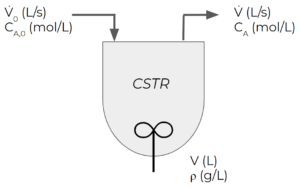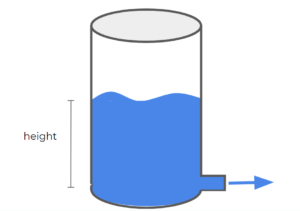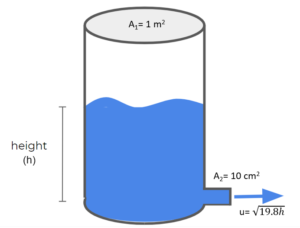40 Separable Differential Equations
Learning Objectives
By the end of this section, you should be able to:
Provide initial conditions for well-mixed separable transient single-unit processes.
Solve separable transient balances to find a property of a system at any given time.
Separable Differential Equations
Separable differential equations are differential equations where the variables can be isolated to one side of the equation. Take the following differential equations:
1 –
This equation is separable because you can completely isolate the x and y variables as follows:
2 –
This equation is non-separable because you cannot completely isolate the x and y variables:
These non-separable equations we will discuss later.
Example: Chemical Reactor
Consider a “continuous stirred-tank reactor” (CSTR). CSTRs are reactors with continuous feed and exit streams and some kind of mixer.
Say we know the following information about this CSTR:
- The feed enters at a constant volumetric flowrate of
- The volume of the tank is
- Initially (
- The exit stream flows at a constant rate of
- We can assume that the density of all streams in the system is constant at

We want to write a balance for the total (overall) mass in the system under transient conditions.
We start off by writing out the overall balance:
Mass is not being consumed or generated, just changed from one substance to another. This means the
The units for the
Since the densities are all constant, we can cancel them out:
Using separation of variables (from calculus), we can integrate both sides. We want to find a given value about our system at a specific final time (
Let’s try substituting in some numbers to this equation. Say the rate of flow in is 5 L/min, and the flow out is 6 L/min with 300 L initially in the tank. How much water remains in the tank after 1 hour? Using the formula we derived, we can find this:
[latex]V_{f} = 300 L+(5 \frac{L}{min} - 6 \frac{L}{min})*(60 min-0 min)$$
Note, you may say this is obvious and there is no need to derive our equation, and in this case our equation was relatively simple. However, we want to get in the practice of formulating these equations for when things start getting more complicated. In this class, we'll focus on formulating these equations rather than finding the solution.
Exercise: Transient Mass Balance
 Assume the tank contains only 1 species (A) and the density is constant. What are the relevant terms in the mass balance for this draining tank? Say at time zero, the height of the tank is 5 m, the tank also has a diameter of 2 m. There is a pump at the outlet pumping A out at a rate of 0.1
Assume the tank contains only 1 species (A) and the density is constant. What are the relevant terms in the mass balance for this draining tank? Say at time zero, the height of the tank is 5 m, the tank also has a diameter of 2 m. There is a pump at the outlet pumping A out at a rate of 0.1 Solution
Step 1: Determine what terms in the general balance are zero or negligible.
Since there are no feed streams and no reactions (no mass generated or consumed), the
Step 2: Write out the mass balance for species A in the system.
Step 3: Expand the mass terms.
Recall that
Since the density is constant, the density terms on both sides cancel each other out
The volume terms can be further expanded. Recall that the volume of a cylinder
Step 4: Solve the integral from t = 0 to t = 10 mins
Exercise: Transient Mass Balance
Suppose we have a tank with an outlet at the bottom as shown below. Water is the only thing in the tank (we'll call this species A). The water flows out of the tank at a rate of

Solution
Step 1: Determine what terms in the general balance are zero or negligible.
Since there is no inlet stream and no chemical reactions in the tank, there is no
Step 2: Write out the mass balance for species A in the system.
Step 3: Express each term using the given quantities:
Replace
Because
The volume of fluid flowing out of a pipe at any instant can be calculated using
For the accumulation term, we can espress dV as
We can replace
Step 4: Solve the integral to find
Separate the equation by moving all terms involving h to one side:
Replace the variables by the given information:


Feedback/Errata